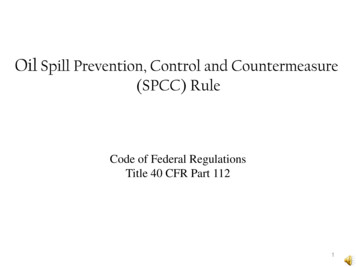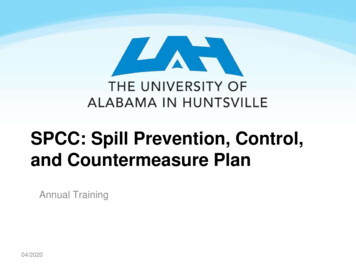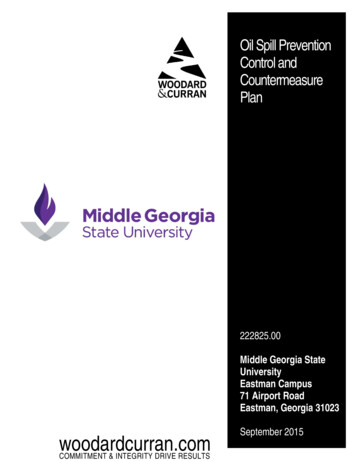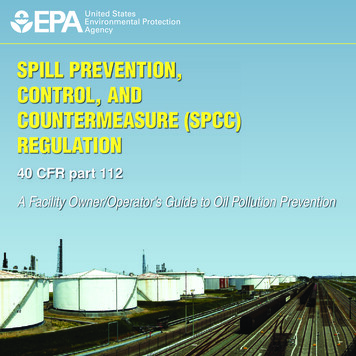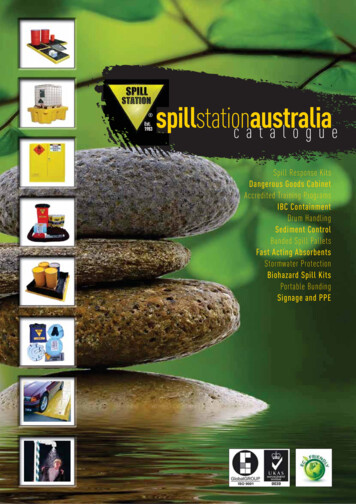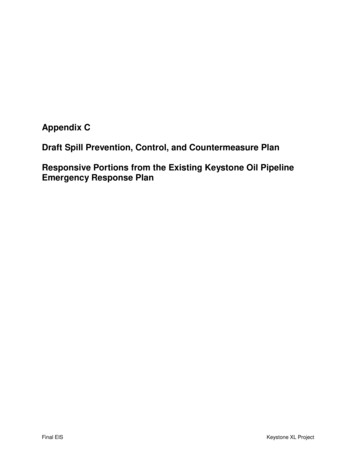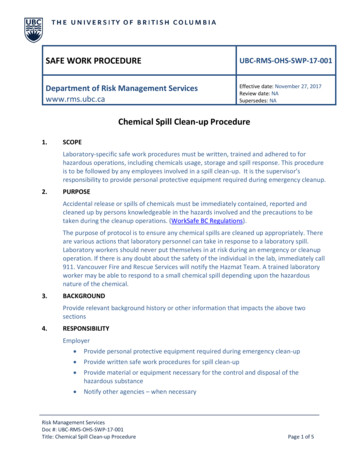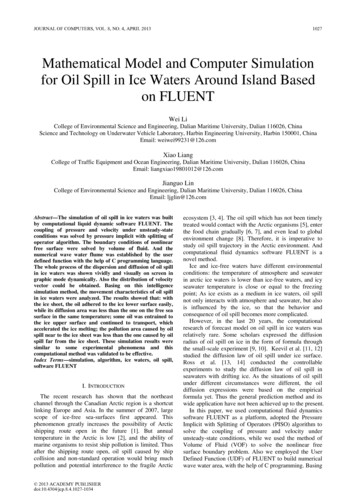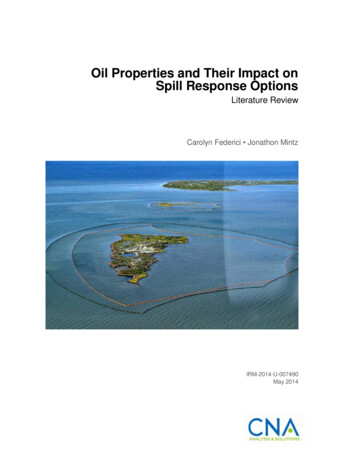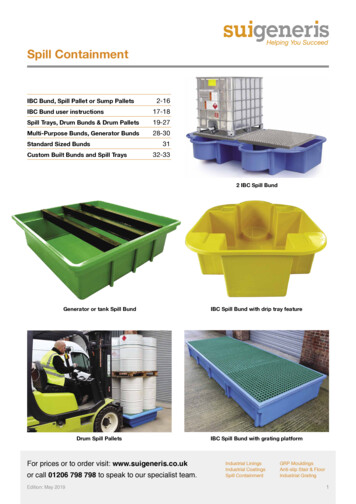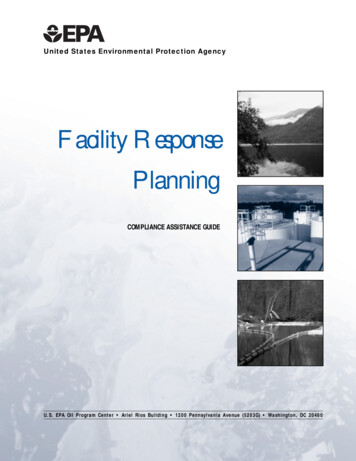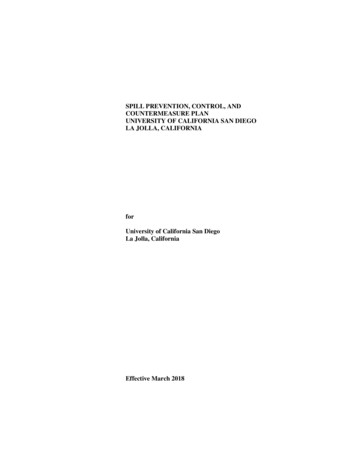
Transcription
SPILL PREVENTION, CONTROL, ANDCOUNTERMEASURE PLANUNIVERSITY OF CALIFORNIA SAN DIEGOLA JOLLA, CALIFORNIAforUniversity of California San DiegoLa Jolla, CaliforniaEffective March 2018
TABLE OF CONTENTSPageLIST OF TABLESLIST OF .iiiiiiPlan OrganizationPlan ApplicabilitySPCC Plan/Program Administration1.3.1 Plan Coordinators and Emergency Contacts1.3.2 Plan Amendments1.3.3 Review and Re-certification of Plan1.3.4 Location of SPCC PlanConformance to Applicable StandardsPlan Certifications1.5.1 Professional Engineer Certification1.5.2 Facility Certification1.5.3 Certification of the Applicability of the Substantial Harm Criteria ChecklistCAMPUS BACKGROUND2.12.22.32.42.52.62.72.82.9UC San Diego Main Campus Description2.1.1 Location and Activities2.1.2 Campus Layout and Site PlanCampus DrainageCampus Storage Capacity2.3.1 Aboveground Storage Tanks (ASTs)2.3.2 55-Gallon Drums2.3.3 Elevators and Transformers2.3.4 Emergency Generators (EGs)2.3.5 Oil Water Separators2.3.6 Underground Storage Tanks2.3.7 Motive Power Containers2.3.8 Cooking Oil ASTsOil Handling Activities2.4.1 Piping2.4.2 Fuel Loading/UnloadingSpill Containment Measures2.5.1 Passive Secondary Containment2.5.2 Active Secondary ContainmentSPILL/RELEASE POTENTIAL AND DIRECTION OF FLOW2.6.1 Fuel Loading/Unloading2.6.2 Leaky Valves or Piping2.6.3 Tank Failure, Rupture or Puncture2.6.4 Mishandling of Drums2.6.5 Hydraulic Systems at Powell ComplexSecuritySpill HistoryEquipment Not Yet Fully 13
3.DISCHARGE CHARGE RESPONSE174.14.217171717184.34.45.Inspections3.1.1 ASTs, Drums, Generators, Mobile Equipment, and Associated Piping3.1.2 Transformers3.1.3 Elevators3.1.4 Spill KitsIntegrity TestingLoading and Unloading Best Management PracticesDischarge of Stormwater from Diked AreasSPCC Education and AwarenessSmall, Incidental ReleasesLarge Spills (Releases of Oil Greater Than 42 Gallons)4.2.1 Oil Spill Contingency PlanEquipment for Spill Response and Personal ProtectionSpill Response ContractorDISCHARGE REPORTING5.1University Reporting5.2Federal Reporting5.3State & Local ReportingREFERENCESTABLESFIGURESAPPENDIX A - Re-Certification of the SPCC PlanAPPENDIX B - Certification of the Applicability of the Substantial Harm Criteria ChecklistAPPENDIX C - SPCC Rule Compliance Cross-WalkAPPENDIX D - Loading and Unloading ProceduresAPPENDIX E – Drainage LogAPPENDIX F - Spill Report FormAPPENDIX G - SPCC Compliance ScheduleAPPENDIX H – Industry Inspection GuidelinesAPPENDIX I – Transformer Inspection GuidelinesAPPENDIX J – Spill Response Contact List1919192123
LIST OF TABLESTable No.TitleISummary of Storage, Use, Prediction of Oil Flow and Direction During ReleaseLIST OF FIGURESFigure No.Title1Site Locus2General Site Map3Site Map – AST’s and Drum Containers4Site Map – Emergency Generators & Mobiles5Site Map – Transformers
1.INTRODUCTIONThis Spill Prevention Control and Countermeasures (SPCC) Plan (Plan) is required for the University ofCalifornia San Diego (UC San Diego) because the volume of aboveground oil storage at the campus isgreater than the applicability threshold under the federal SPCC regulations (40 CFR 112). A SPCC Planis required for facilities which have an aggregate aboveground storage capacity of oil greater than 1,320gallons in containers greater than 55-gallons in capacity. As of the preparation date of this SPCC Plan,UC San Diego’s aboveground oil storage capacity is approximately 200,000 gallons.UC San Diego operates underground storage tanks (USTs) containing petroleum products, however, theUSTs are subject to the technical requirements of 40 CFR, Part 280, as well as the state analogue to thesefederal regulations. Consequently, the USTs are exempt from SPCC plan requirements except foridentification of their locations on the Site Plan.This SPCC Plan has been prepared in accordance with good engineering practices. This SPCC Plan hasthe full approval of UC San Diego management to commit the necessary resources for implementation.1.1Plan OrganizationThis SPCC Plan is divided into the following five sections:IntroductionSection 1 presents the administrative elements of the SPCC Plan including the Plan’s overallconformance with State and Federal SPCC regulations, where the Plan is located, who maintains controlover the Plan, the process and requirements for updating/modifying the Plan, and certifications.Campus BackgroundSection 2 provides a physical description of UC San Diego’s’ campus and its oil storage locations, inplace containment measures, and potential release scenarios. Section 2 provides an overview of UC SanDiego’s’ campus, discusses oil storage/handling locations and practices, and provides details about whereand how a release would impact the Site. The Section specifically discusses oil storage inventory, activeand passive spill containment, facility drainage, release scenarios, and historical spill events.Discharge PreventionSection 3 begins the active portion of this SPCC Plan. This section discusses requirements forinspections, integrity testing, best management practices, personnel training, plan amendment, planreview, and recordkeeping. These are actions that must be performed by UC San Diego personnel on acontinual basis to prevent oil discharges from occurring.Discharge ResponseSection 4 describes the response actions and activities that will lead UC San Diego personnel in the eventoil is discharged to the environment. A discussion of discharge event sizes, discharge notificationprocedures, and spill response activities are provided.Discharge ReportingSection 5 describes the verbal and written requirements associated with a discharge event. Federal andState reporting is discussed as well as recordkeeping requirements.1
1.2Plan ApplicabilityThis SPCC Plan was written specifically for UC San Diego’s main campus located on Gilman Drive, inLa Jolla, California (Figure 1). The campus is generally bounded by Genesee Ave. to the north, TorreyPines Road and La Jolla Village Drive to the south, Regents Road to the east, and Torrey Pines Road andthe Pacific Ocean to the west. Interstate Highway 5 (I-5) passes through the eastern portion of thecampus, separating the main campus from the UC San Diego Medical Center and Mesa Housing. TheScripps Institute of Oceanography (SIO), located to the southwest of the main campus, is included as partof the main campus for purposes of this SPCC Plan.1.3SPCC Plan/Program AdministrationThe Campus SPCC Coordinator will maintain control over the SPCC Plan/SPCC Program and willengage UC San Diego Departments: Resource Management & Planning (RMP), Housing, Dining &Hospitality (HDH), UC Health Systems, and Student Affairs (SA) for management of containers and oilhandling activities, as necessary.1.3.1Plan Coordinators and Emergency ContactsThe Campus SPCC Coordinator is:Name: Tod FergusonTitle: Hazardous Materials Business Plan Manager9500 Gilman Drive #0089La Jolla, CA 92093-0089Office Phone: 858.534.9745Office Fax: 858.534-1564The Campus SPCC Coordinator is responsible for overall administration of this SPCC Plan,including amendments, certifications, reporting, record-keeping, education, and spill response. Inaddition, the Campus SPCC Coordinator is responsible for coordinating inspections andmaintaining records of inspections and spill incidents.1.3.2Plan AmendmentsThis SPCC Plan must be amended whenever there is a change in campus design, construction,operation or maintenance which materially affects the campus’ potential for the discharge of oilinto or upon the navigable waters of the United States or adjoining shorelines. Such changes mayinclude, but are not limited to: Addition to or reduction of oil storage capacity;Types of oil materials stored, used or generated;Modifications to containment areas;Drainage system modifications; andChanges in SPCC Plan coordination and/or emergency contact numbers.A registered Professional Engineer (P.E.) must certify all non-administrative amendments to theSPCC Plan.2
1.3.3Review and Re-certification of PlanRegardless of whether changes have occurred at the campus, this SPCC Plan must also bereviewed and evaluated at least once every five years. If the review identifies an increasedpotential for a release, the SPCC Plan will be amended within six months to include moreeffective prevention and control technology if such technology will significantly reduce thelikelihood of a spill event at the campus, as long as such technology has been field-proven at thetime of the review. The SPCC Plan may be periodically amended to reflect changes in thecampus. Any technical amendments to the SPCC Plan must be re-certified by a P.E.The five-year SPCC Plan review and evaluation will be documented by signing a statement as towhether the Plan will be amended. The following statement will suffice: “I have completedreview and evaluation of the SPCC Plan for University of California San Diego on (date), andwill (will not) amend the Plan as a result.” This statement must be included in the Plan(Appendix A).1.3.4Location of SPCC PlanThis SPCC Plan will be maintained at UC San Diego’s Environment, Health and SafetyDepartment located at 9500 Gilman Drive, La Jolla, California and shall be made available to theLocal Agencies and the United States Environmental Protection Agency (EPA) RegionalAdministrator, if so requested.Hard copies of the SPCC Plan may be distributed to RMP, HDH, UC Health Systems, and SA, asrequested. An electronic copy of the SPCC Plan is also available online at the Environment,Health & Safety Department’s Blink webpage.1.4Conformance to Applicable StandardsThis SPCC Plan is in conformance with the most current SPCC regulations, which were last amended on5 November 2009. In complying with the applicable requirements of the SPCC regulations, 40 CFR 112,no deviations were employed or claimed in this SPCC Plan. This facility has met the generalrequirements for this SPCC Plan listed under 40 CFR 112.7 and the specific discharge prevention andcontainment procedures listed in 40 CFR 112.8. The required Substantial Harm Criteria screening forexemption from developing a facility response plan has been completed and is found in Appendix B. Across-reference guide is provided in Appendix C which demonstrates this SPCC Plan’s compliance withSPCC rule requirements.In addition to conformance with the federal SPCC rules, this facility is in conformance with the followingCalifornia State requirements:Hazardous Materials Release Reporting - 19 CCR, Section 2703 (Hazardous Materials BusinessPlan); California H&SC Division 20, Chapter 6.67 (Aboveground Petroleum Storage Act)The Aboveground Petroleum Storage Act (APSA) requires owners and operators of tank facilities toprepare and implement a SPCC plan in accordance with part 112 of Title 40 of the federal Code ofRegulations. Pursuant to H&SC 22507(a) and 19 California Code of Regulations 2703: A handler must,upon discovery, immediately report to the Certified Unified Public Agency (CUPA) and CaliforniaEmergency Management Agency (EMA) any release or threatened release of a hazardous material if thereis a reasonable belief that the release or threatened release poses a significant present of potential hazard3
2.CAMPUS BACKGROUNDThis section provides a description of SPCC-related features and activities at UC San Diego’s maincampus. It provides essential details of the oil storage capacity, passive secondary containmentstructures, active secondary containment measures, potential discharge volumes of onsite containers, andthe discharge direction. This section forms the baseline background information for this SPCC Plan.2.1UC San Diego Main Campus Description2.1.1Location and ActivitiesUC San Diego operates under the University of California System of the State of California. TheUC San Diego main campus comprises over 500 buildings including: administrative, academic,residential, and maintenance buildings, playing fields and gymnasiums, located on approximately1,200 acres in La Jolla, California. The campus is generally bounded by Genesee Ave. to thenorth, Torrey Pines Road and La Jolla Village Drive to the south, Regents Road to the east, andTorrey Pines Road and the Pacific Ocean to the west (Figure 1). I-5 passes through the easternportion of the campus, separating the main campus from the UC San Diego Medical Center andMesa Housing. SIO is located to the southwest of the main campus and is bounded on the west bythe Pacific Ocean.The campus is primarily used for student housing, academic buildings, athletics, administrativeoffices, research, and maintenance services. UC San Diego operates on a year round basis withstudent related activities operated on a quarter basis, with the first quarter beginning in Septemberand ending in December, the second quarter beginning in January and ending in March, and thethird quarter beginning in April and ending in June. During the summer months, the campus isused for summer camps and a limited summer class schedule.Site activities related to the storage and handling of oil in containers equal to or larger than 55gallons (SPCC covered) include:2.1.2 Motor vehicles, maintenance vehicles (trucks, lawn mowers, etc.), public transportation(buses) - gasoline and diesel fuel storage and dispensing; Emergency generators - diesel fuel storage; Electrical transformers – transformer oil storage; Vehicle maintenance – storage of virgin motor oil and collection of used motor oil; Elevators and hydraulics lift systems – hydraulic oil storage; and Drum and aboveground storage tank (AST) storage of petroleum hydrocarbons.Campus Layout and Site PlanThe General Site Map (Figure 2) presents a layout of the campus. The Site Plans (Figures 3-5)present the location and contents of aboveground storage tanks (ASTs), drums, emergencygenerators, mobile generators and refuelers, and transformers. Pursuant to SPCC Rulerequirements for a facility diagram outlined in CFR 112.7(a)(3), the following items are identifiedin the Site Plan:6
2.2 ASTs and USTs (including content and capacity); Mobile portable containers (including content and capacity); Hydraulic operating systems or equipment; Oil-filled electrical transformers (including content and capacity); Oil/water separators (OWS); and Oil transfer areas and unloading areas.Campus DrainageStorm water from paved drives, parking areas, and loading docks throughout the campus is directed to aseries of catch basins which drain to a storm drain system. Depending on location, UC San Diego stormdrains discharge to the City of San Diego storm drain system flowing north towards Sorrento Valley,south towards Rose Creek, and west towards the Pacific Ocean. UC San Diego storm drains in thevicinity of SIO also discharge directly to the Pacific Ocean.Near the Central Garage and the CSC Grounds Shop two OWS separate oil from vehicle wash rack andgrounds maintenance wash rack operations prior to discharge to the sanitary sewer system.Floor drains located inside buildings connect to the sanitary sewer system. All 55-gallon drums eitherhave or are planned to have secondary containment provided by spill pallets or by the room itself whichlimits offsite drainage pathways to the drains only.There are several outdoor oil storage and oil-containing equipment areas that have secondary containmentthat require the management and discharge of accumulated storm water. These areas of secondarycontainment are subject to storm water accumulation, which must be released in accordance with CFR112.8(b)(1-2) and 112.8(c)(3), as discussed in Section 3.5.2.3Campus Storage CapacityA list of oil storage containers regulated under this SPCC plan and their locations within the UC SanDiego campus is provided in Table I and depicted on Figures 3 through 5. All containers with a capacityequal to or greater than 55 gallons are included as part of this SPCC Plan. As of the preparation date ofthis SPCC Plan, UC San Diego’s aboveground oil storage capacity is approximately 200,000 gallons.Passive and active controls implemented to prevent and contain spills of these materials are described inSection 3 of this plan. A description of the locations of oil stored at the campus is provided in thefollowing sections.2.3.1Aboveground Storage Tanks (ASTs)Diesel fuel, hydraulic oil, and waste oil are stored throughout the UC San Diego main campus,with the largest stores being located at: the Campus Services Complex (CSC), Powell StructuralLaboratory, High Bay Physics, Central Utilities Plant (CUP), East Campus Utility Plant, andScripps Institution of Oceanography (SIO) areas.7
UC San Diego also has mobile fuel bowsers which are used to refuel emergency generators andprovide emergency fueling, as necessary. The mobile fuel bowsers are trailer-mounted tankswhich are parked at the CSC, when not in operation.2.3.255-Gallon DrumsFifty-five gallon drums store petroleum hydrocarbons, diesel fuel, and waste oil at variouslocations across the campus. Most of these drums are stored inside buildings. The total capacityof 55-gallon storage is based on a combination of observed conditions and maximum storagecapacity given existing secondary containment pads.2.3.3Elevators and TransformersThe UC San Diego’s main campus has passenger elevators with hydraulic storage capacitiesranging from 80 to 150 gallons.The UC San Diego main campus has electrical transformers with oil storage capacities rangingfrom 100 to 5,160 gallons.2.3.4Emergency Generators (EGs)The UC San Diego main campus currently owns and operates stationary and mobile EGs. MostEGs have double-walled belly tanks ranging from 55 gallons to 7,500 gallons. Others havedouble-walled day tanks ranging from 250 to 1,000 gallons.2.3.5Oil Water SeparatorsBoth OWS are exempt from all SPCC requirements in accordance with Section 112.1(d)(6) anddo not count toward facility storage capacity. Two OWSs are located at the CSC near the PPSGrounds and the Central Garage buildings. One OWS captures oil associated with washing thestreet sweeper and the other captures car/bus wash water.2.3.6Underground Storage TanksAll USTs are exempt from all SPCC requirements in accordance with Section 112.1(d)(4) and donot count toward facility storage capacity. These USTs are regulated under 40 CFR 280 and Title23 California Code of Regulations (CCR) Sections 2632(d)(2), 2632(e)(2) and 2641(h). UC SanDiego monitors USTs according to its UST Monitoring Plan.2.3.7Motive Power ContainersThe fuel stored by motive power containers will not be added to the cumulative campus storagecapacity because of exemption under 40 CFR 112.1(d). Fleet vehicles are considered by the EPAto be motive power containers because the fuel they carry is for self-propulsion (EPA 2008).2.3.8Cooking Oil ASTsAll aboveground cooking oil/grease tanks located at UC San Diego store less than 55-gallonstherefore are not covered as part of this SPCC Plan.8
2.4Oil Handling Activities2.4.1PipingPiping transfers of oil at the UC San Diego campus include: Diesel or gasoline transfer to various sites across campus using the fueling truck; CSC Fueling Island; Central Utilities Plant; Thornton Hospital; EGs with day tanks: –Pacific Hall–EBU-1–EBU-2–ECUP (two EGs)–Geisel Library–CUP (four EGs)–Natural Sciences–Recreation, Intramural, and Athletics Complex (RIMAC)–Sanford Consortium for Regenerative Medicine–SIO T-43;–Stein;–Thornton Hospital;–Warren College Canyon Vista; checkPowell Complex – transfer of hydraulic oil to Powell Composites Laboratory andbetween buildings at High Bay Physics Lab.The piping used for all these transfers is properly supported to minimize abrasion and corrosionand allow for expansion and contraction in accordance with CFR 112.8(d)(3).2.4.2Fuel Loading/UnloadingFuel loading (adding fuel or oil to ASTs, USTs, mobile generators, mobile fuel bowsers, or fleetvehicle) occurs at the following locations: CSC Fueling Island; EGs (belly tanks); CUP; Thornton Hospital; Re-used 55-gallon drums or 330-gallon totes; and9
ASTs (day tanks for EGs).Fuel delivery schedules vary, depending on usage, and all deliveries of fuel are not overseen byUSCD personnel. When USCD personnel are not available to oversee the fueling activities, spillprevention activities are the responsibility of the fueling contractor, pursuant to conditions of theircontract with UC San Diego. UC San Diego-approved fueling procedures, at a minimum, mustbe implemented by all USCD personnel when undergoing fueling activities and by all UC SanDiego contractors during fuel loading or unloading. Complete fueling procedures are provided inAppendix D and are summarize as:2.51.Check the level in the receiving tank for adequate capacity. Chock the wheels of the truckbefore transfer lines are connected.2.Check the transfer hose(s) for leaks, wear, or potentially faulty valves.3.Open the storage tank fill pipe and connect the transfer hose from the tank truck.4.Monitor the level in the tank during fuel transfer.5.After completion of fuel transfer, disconnect the hose from the fill pipe and secure the fillpipe cover. Place the transfer hose(s) back onto the tank truck in its normal storageposition.6.Remove the wheel chocks.7.Inspect the fueling area for any minor or major leaks. If a leak has occurred, followappropriate reporting and notification procedures. Clean-up minor spilled amounts (lessthan one gallon) with appropriate equipment (absorbent pads, speedy dry, etc.)Spill Containment MeasuresThe material and construction of oil storage containers present at the campus are compatible with thematerial stored and conditions of storage such as pressure and temperature.Secondary containment can be provided through passive or active measures. Passive measures arepermanent installations that do not require deployment or action by the owner/operator. Conversely,active measures are those that require deployment or other specific action by the owner/operator. Bothpassive and active secondary containment measures are implemented at UC San Diego’s main campus.2.5.1Passive Secondary ContainmentThe following are passive secondary containment methods that are implemented for bulk storagecontainers at UC San Diego. They provide a means of containment for the largest singlecontainer and sufficient freeboard to contain precipitation.DikingDikes provide secondary containment, or tertiary containment, for many AST and generators asidentified on Table I. In order to provide adequate secondary containment, diked areas must beable to hold 110% capacity of the storage container including calculations for precipitation(standard calculations include precipitation values for a 24-hour, 25-year storm event).55- Gallon Drums10
All 55-gallon drums have, or are planned to have, secondary containment provided by spill palletsor covered spill pallets.Secondary Containment Provided by Building/RoomAll elevator hydraulic reservoirs are located in buildings with equipment rooms, which providesecondary containment.The majority of 55-gallon drums located at UC San Diego’s main campus have secondarycontainment provide by spill pallets but otherwise all indoor drums have secondary containmentprovided through the room in which they are stored.The hydraulic oil tank (7,500-gallon), the “junior” shaker table tank, and each of the three 500gallon pump tanks in the High Bay Physics facility are single-walled steel tanks. The two 330gallon totes are polyethylene and the 2-inch diameter transfer piping is a fiber composite suitablefor high pressure liquid transfer. All are within secondary sized containment structures.2.5.2Active Secondary ContainmentThe SPCC rule allows for the use of sorbent materials and drip pans to function as activesecondary containment measures for other than bulk storage containers (Section 112.7 [c]).These measures may be deployed either before an activity involving the handling of oil starts, orin reaction to a discharge. Spill kits can be used as an active measure during oil transferoperations.Active Measures in Unloading, Loading, and Mobile Refueling AreasLoading/unloading of petroleum products occurs at UC San Diego’s main campus as discussed inSection 2.4.2 (adding fuel or oil to ASTs, USTs, mobile generators, mobile fuel bowsers, or fleetvehicle).The CSC Fueling Island piping consists of two dispensers with flexible hoses and metal nozzles.The nozzles and rubber hose materials are compatible with both gasoline and diesel fuels. Theoperating system, associated with the dispensing nozzles, disconnects the pump power if thedispenser is not activated within 5 seconds of its removal from the cradle. This system must bereset before fuel can be pumped at that dispenser. The hose and nozzle dispensers are alsoequipped with standard break-away fittings to prevent damage to the dispenser and island if avehicle drives away with the nozzle attached to the fuel tank.Fuel delivery trucks and mobile refuelers use a single hose connection to unload fuel to ASTs,USTs, EGs, or vehicles at fueling areas designated on the Site Plan (Figures 3 through 6).Active measures during unloading operations include, but are not limited to, using spill kits tocontain a discharge, placing a drain cover over a sewer drain prior to or in response to adischarge, and placing drip pans under mechanical piping connections to contain small leaks andspills.11
Active Measures for TransformersWith few exceptions, oil-filled transformers have singled-walled steel tanks and do not have sizedsecondary containment provided by dikes. As a result, spill kits will be made available duringmaintenance activities and during inspections to provide an active form of spill countermeasure.The transformer inspection schedule is discussed in Section 3.1.2.2.6SPILL/RELEASE POTENTIAL AND DIRECTION OF FLOWThe sources of potential oil releases at the UC San Diego campus are listed below. This section isintended to provide the information required in section 112.7 (b) of the SPCC Regulations. Controls andcountermeasures implemented by UC San Diego to mitigate or respond to potential releases to theenvironment are described in Sections 3 and 4, respectively. Potential release volumes, direction of flow,and ultimate discharge locations are presented in Table I.2.6.1Fuel Loading/UnloadingA release could occur at the AST or UST locations if the delivery truck’s hoses are not properlyconnected, if hoses or valves fail, if disconnection is not properly performed (i.e., still pumpingwhen hose is disconnected), or if the tank is overfilled.2.6.2Leaky Valves or PipingValves may leak if they are not entirely closed or may leak if they are old and/or corroded.Piping may leak due to corrosion or through fittings. Generally, leaks of these types are slow andwill likely be mitigated through regular monthly inspections conducted for the associatedcontainer, as discussed in Section 3.1.1.As discussed in Section 2.6.5, the only underground piping at UC San Diego’s main campus isthe hydraulic system at the Powell Complex.2.6.3Tank Failure, Rupture or PunctureA release from an AST (including EGs and transformers) may occur if the tank integrity is weak(e.g., slow leak through a weld seam in a tank), or if the tank ruptures due to an outside force(e.g., vehicle hitting a tank). These scenarios are unlikely, but deserve attention due to theproximity of the tanks to vehicular traffic and the Pacific Ocean.2.6.4Mishandling of DrumsDrums are located at various locations across the campus. A release of oil could occur if a drumis knocked over during transport, or inadvertently drained or punctured. If a release occurredmany drums are located in buildings and all drum storage locations have spill kits located nearby.2.6.5Hydraulic Systems at Powell ComplexIt is possible that a release of hydraulic oil from the pumps or the piping at the Powell Complexcould occur if a transfer hose failed. The hydraulic oil from pumps or piping would flow in theconcrete-lined trenches until it reached the closed sump in the Powell Composites building. Fromthere it would be pumped out and disposed of off-site.12
A release to the environment from the hydraulic oil AST (7,500-gallon) in the High Bay Physicsbuilding is unlikely because the tank is located inside the building with adequate epoxy-coatedconcrete secondary containment.A release from the two 330-gallon totes or the “junior” shaker table tank would be contained bythe building, therefore a release to the environment is unlikely. A third tote located outside istypically empty and adequate sized temporary secondary containment is provided when in use.2.7SecurityThe following is a list of site security measures used to mitigate potential releases of oil: A dedicated staff of security personnel monitors the general security for the UC San Diego maincampus 24-hours per day. Campus security personnel are cognizant of oil storage locations; Adequate lighting is provided at areas where oil is stored; Many oil storage and oil-containing equipment locations are fenced and locked or are located inrestricted access areas; and The fueling equipment can be powered off when the campus is closed.2.8Spill HistoryThere have been no reportable releases of oil or oil-containing materials at UC San Diego in the last fiveyears. In the event a reportable release of such materials occurs in the future, this plan will be amended todescribe the incident(s), the clean-up procedures, and the structural and/or non-structural controlssubsequently implemented to minimize the potential for additional releases. Copies of all spill reportsmust be appended to this plan (Appendix F).2.9Equipment Not Yet Fully OperationalThis SPCC Plan meets the requirements of the SPCC Rules. Any compliance issues and their subsequentcorrective actions are listed in Appendix G.13
3.DISCHARGE PREVENTIONThis Di
5 November 2009. In complying with the applicable requirements of the SPCC regulations, 40 CFR 112, no deviations were employed or claimed in this SPCC Plan. This facility has met the general requirements for this SPCC Plan listed under 40 CFR 112.7 and the specific discharge prevention and containment procedures listed in 40 CFR 112.8.
